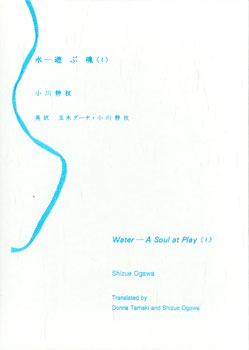A Soul at Play by Shizue Ogawa
5 vols., 2 CDs. Donna Tamaki, Soraya Umewaka, and the author, trs. Konan City, Japan. Ishibe-higashi. 1999–2012. ISBN 9784944229765, 9784944229534, 9784944229710, 9784904625002, 9784904625019
 Shizue Ogawa depicts the relationship of water, wind, fire, and sound to earth, animals, insects, plants, and humans. This relationship conveys a serene, respectful sense of place and balance that draws its power from Buddhist and Shinto metaphysics. Fecund sadness alternates with buoyant plenitude, a simple object with its cosmic opposite: “The bowl quietly / looks up at the heavens. / Humbly it receives the stars / and serves them up. / Curved like the sky . . .”
Shizue Ogawa depicts the relationship of water, wind, fire, and sound to earth, animals, insects, plants, and humans. This relationship conveys a serene, respectful sense of place and balance that draws its power from Buddhist and Shinto metaphysics. Fecund sadness alternates with buoyant plenitude, a simple object with its cosmic opposite: “The bowl quietly / looks up at the heavens. / Humbly it receives the stars / and serves them up. / Curved like the sky . . .”
Violence at times intrudes with physical and sensorial aggression. Violence is the untold anguish behind the phenomenology of one’s own cremation. This violence claws at the soul’s darkness like the surrealistic paintings of Jerome Bosch or Brueghel the Elder. It unveils a cultural and epochal divide that requires extreme poetic precision from the poet and undivided attention from the reader. Yet gentleness softens this exacting structure: “The voices of the poet are the voices of the wind, / Diffusing small ripples in the water.” The poet patiently weaves her favorite themes, the end of summer and beginning of fall, a blissful time of festivals, harvest, and full moon, in a playful mode.
The concept of “play” permeates Ogawa’s poetry. She credits her mentor, Josaburo Ogino, for encouraging her to pursue this unifying theme or, rather, four themes. First is playfulness, the subtle teasing of friends, a gift of not-so-tasty pickled Japanese peppercorns, the romance of insects and trees, a woodpecker “doing his homework at night,” or inspectors checking the croaking of frogs to determine a summer evening’s happiness. Second, play helps translate reality into the imaginary: underground elves pour color into the roots of a rainbow that the poet drags across the sky like a kite; a fish orchestra plays, dances, and sings in a moonlit river; a sad winter tree conceals pictures inside its trunk. Third, play is the creation of an independent poetic support, the fleeting and imponderable texture of air, water, or wind: “Beside the full moon of August / a mountain swayed flimsily like a reflection on the water.”
Fourth, play belongs to the world of theater. The poem “Sound” exemplifies the “staging” of a poem. It is built en abîme, with the poet standing in front of a real scene (or a painting) of weavers in a room that contains a tempera painting representing musicians. The poem weaves sounds into threads and colors into sounds, as the two scenes intersect. The poet, then the reader, are drawn into the painting(s) and help sort out and stage the stories. The use of the first person by the poet further invites the reader to participate fully in the action.
The exquisite and discreet construct of the poems weaves playfulness, translation, poetic space, and theater, to make ordinary events happening to ordinary beings into extraordinary segues to the poetic experience. Ultimately, all these “play” techniques create a home with multiple dimensions, a hiding place, a poignant place of absence: “My house is in the sea. / A sharp boulder protrudes from the seabed, / and my house sits on the tip . . . / So deep is the sea that no waves rise up, / and no wind blows . . . Then one day / my house yielded to the swirling water / and began to sway slowly . . . / The cold, brown seawater will embrace me. / Only then can I calmly call out the names of my family.”
Born on Hokkaido Island, Shizue Ogawa is a specialist of John Keats who teaches British literature at Kansai University and, currently, international culture at Osaka University of Education.
Alice-Catherine Carls
University of Tennessee at Martin
(Editorial Note: To listen to some of the poems on the two disc audio set, see [node:621 title"Bilingual Recordings, A Soul at Play by Shizue Ogawa"].)

